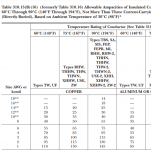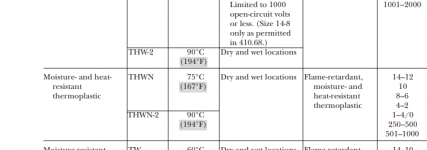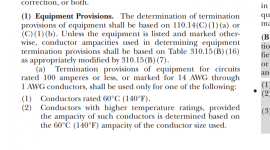hitehm
Senior Member
- Location
- Las Vegas NV
Hey All - Referring to the test question below, I'm not sure their answer is correct and could use some help. They are allowing the ampacity of the conductor to be lower than the adjusted ampacity based on the OC protection following the next size up rule. But shouldn't the ampacity requirement be satisfied FIRST and THEN the next size up rule can apply? Meaning, the 80% derate for 4 or more conductors says the THWNs in their question need to have an adjusted ampacity of 125A minimum to compensate for the additional wire on the possible total LOAD of 100A from the feeder: 125 * .8 = 100A when derated. You still need 125A 75deg rated wire to carry the adjusted current. So doesn't the next size up rule only apply ONCE the ampacity for the wires is satisfied?
A simple example to my point: You have a non continuous appliance that has a FLA of 85A. You select #4 THWN wire, which has an ampacity of exactly 85A. The ampacity is now satisfied. However, 85 is NOT a standard OCPD so you can next size up to a 90A breaker. The 90A OCPD is protecting a wire with an ampacity of 85A per the next size up rule, which is OK b/c the #4 wire is capable of carrying the 85A needed current. Again, the ampacity requirement has been satisfied first. I don't see this applying to their question though.
Test Question:
A simple example to my point: You have a non continuous appliance that has a FLA of 85A. You select #4 THWN wire, which has an ampacity of exactly 85A. The ampacity is now satisfied. However, 85 is NOT a standard OCPD so you can next size up to a 90A breaker. The 90A OCPD is protecting a wire with an ampacity of 85A per the next size up rule, which is OK b/c the #4 wire is capable of carrying the 85A needed current. Again, the ampacity requirement has been satisfied first. I don't see this applying to their question though.
Test Question:
| 18. | In the interior of a finished commercial facility, you are asked to add a new 100 ampere subpanel, fed with a 100A 3 phase 4 wires plus ground feeder from the main service equipment, which is sitting 50' away. Both the new subpanel and the existing main are surface mount units, and you can install surface mounted EMT conduit. You are given no details of what the load will be. Without applying any exceptions or special conditions requirements, what is the minimum THWN copper wire size that you can use for the current carrying conductors?
310.15(B)(3)(a) requires an ampacity adjustment for more than 3 current carrying conductors, and since you do not know what the loads are, you must count the neutral. Table 310.15(B)(3)(a) shows an 80% adjustment factor needing to be applied, Table 310.15(B)(16) shows #2 THWN having an ampacity of 115A: 115A x 80% = 92A. 240.4(B) allows you to use the next size up if ampacity is not equal to a standard size, therefore this wire can be connected to a 100 breaker. |




